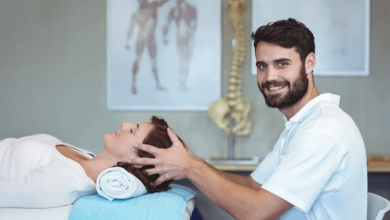The Right Foundation for Gyms

Designing a commercial fitness center is more than just selecting gym equipment or laying out training zones. One of the most crucial elements that contributes to both safety and performance is the floor beneath your feet. Selecting the right commercial gym flooring can drastically affect the user experience, facility maintenance, and long-term operational costs. With multiple materials and configurations available today, gym owners must understand their options to create a safe, functional, and visually appealing environment.
Why Commercial Gym Flooring Is a Game-Changer
When people think of gym essentials, they typically imagine dumbbells, machines, or treadmills. However, the surface that supports all of this is often overlooked. Commercial gym flooring acts as a shield, absorbing shocks, reducing noise, and providing the traction needed to prevent injuries.
Whether your gym offers powerlifting, cardio classes, functional fitness, or yoga, every activity demands a different type of support. A well-planned floor can prevent structural damage, improve hygiene, and enhance overall aesthetics.
Key Benefits of Commercial Gym Flooring
1. Shock Absorption and Injury Prevention
High-impact workouts like weightlifting or plyometrics can lead to strain or injury without proper flooring. Rubber and foam materials help absorb the impact, protecting joints and softening landings. This reduces injury risks for users and protects subfloors from equipment damage.
2. Durability and Longevity
Unlike residential flooring, commercial gym floors are designed for constant wear and tear. They withstand thousands of steps, dropped weights, and intense cleaning routines. With the right flooring, replacement cycles are dramatically reduced.
3. Noise and Vibration Control
Gyms are naturally noisy, especially during peak hours. Cardio equipment, dropped weights, and movement can echo through the building. commercial gym flooring helps minimize noise, creating a more pleasant experience for gym-goers and nearby businesses.
4. Water and Slip Resistance
Sweat, spilled water, and cleaning agents can create slippery surfaces. High-quality flooring provides essential grip and minimizes slip risks, even when wet. This ensures a safer training environment for everyone.
See also: The Vital Role of Advanced Imaging in Modern Healthcare
5. Easy Cleaning and Hygiene
Maintaining hygiene is critical in any fitness facility. Modern rubber and vinyl flooring options resist bacteria and moisture, making them easy to clean. This is especially vital in areas like stretching zones, locker rooms, and restrooms.
Types of Commercial Gym Flooring Materials
The best flooring solution depends on your facility type and the specific workouts you offer. Here are the most commonly used materials in commercial gym environments:
Rubber Flooring
Rubber remains the most widely used material for gym floors due to its shock-absorbing properties, durability, and moisture resistance. Available in tiles, rolls, or mats, rubber is suitable for almost all fitness zones.
- Best for: Weight rooms, general fitness zones, cardio areas
- Pros: Long-lasting, easy to clean, sound dampening
- Cons: Can be heavy and more expensive upfront
Foam Tiles
Foam offers cushioning and is easy to install, often used in lighter workout spaces such as yoga studios or bodyweight training zones.
- Best for: Kids’ fitness areas, yoga rooms, stretching zones
- Pros: Lightweight, affordable, soft underfoot
- Cons: Not suitable for heavy weights or machinery
Vinyl Flooring
Vinyl is sleek and resistant to water, often used in multipurpose rooms or group class studios. It offers style without compromising functionality.
- Best for: Dance studios, Pilates, locker rooms
- Pros: Stylish, stain-resistant, easy maintenance
- Cons: Limited shock absorption
Artificial Turf
Turf is rising in popularity for functional training and athletic conditioning areas. It allows users to perform sled pushes, sprints, and agility drills with ease.
- Best for: Functional training zones, sports training facilities
- Pros: Highly durable, unique appearance, low maintenance
- Cons: Not suitable for heavy lifting
Zones That Require Specific Flooring Solutions
When designing your gym layout, it’s important to match flooring type to specific workout functions:
| Gym Area | Recommended Flooring |
|---|---|
| Free Weight Area | 10–20mm Rubber Tiles or Mats |
| Cardio Equipment | 6–8mm Rubber Rolls |
| Group Training Studio | Vinyl or Interlocking Rubber |
| Stretching Zones | Foam or Light Rubber |
| Functional Area | Artificial Turf or Heavy Rubber |
| Locker Rooms | Moisture-Resistant Vinyl |
Each of these areas has unique demands, and commercial gym flooring should meet those requirements while maintaining a cohesive design.
Design and Branding Considerations
Flooring doesn’t have to be boring. Commercial rubber and vinyl flooring now come in a wide range of colors, textures, and even custom branding options. You can choose flooring that complements your gym’s logo, colors, or general vibe. For example, using different floor colors to define zones helps guide users intuitively while enhancing the aesthetic appeal.
Many manufacturers also allow custom-cut tiles with logos embedded directly into the surface, giving your facility a premium, personalized look.
Installation Tips and Considerations
Professional installation is highly recommended for commercial gyms due to the weight and precision required. However, understanding the basics helps in selecting the right product and ensuring longevity.
- Subfloor Preparation: Floors must be clean, flat, and moisture-free.
- Adhesive vs. Interlocking: Permanent installations (rolls and some tiles) often require adhesive, while interlocking tiles are easier to remove or replace.
- Edge Transitions: Smooth transitions between different materials prevent tripping hazards and enhance durability.
Maintenance Guidelines for Longevity
Routine care extends the life of commercial gym flooring and maintains hygiene:
- Daily: Dry mop or vacuum to remove dust and debris
- Weekly: Damp mop using a pH-neutral cleaner
- Monthly: Deep clean using auto-scrubbers (for large spaces)
- Annually: Inspect for wear or damage, and replace worn tiles or mats
Avoid oil-based cleaners or harsh chemicals, especially on rubber surfaces, to prevent breakdown.
Environmental Impact and Sustainability
Many gym owners today prioritize eco-friendly building solutions. Rubber flooring made from recycled materials, such as old tires, supports sustainability without sacrificing quality. These materials perform just as well as virgin rubber and help reduce landfill waste. Moreover, sustainable flooring options may contribute to earning LEED certification for your commercial space.
Final Thoughts
The right commercial gym flooring is more than a foundation—it’s a critical investment in safety, performance, and style. From supporting heavy lifting to providing a clean surface for yoga practice, each area in your gym requires a floor designed for its specific purpose. With the range of high-quality, eco-friendly, and visually appealing flooring solutions now available, gym owners can find the perfect match for every training zone.
Choosing thoughtfully today means fewer repairs, happier clients, and better gym performance tomorrow.





